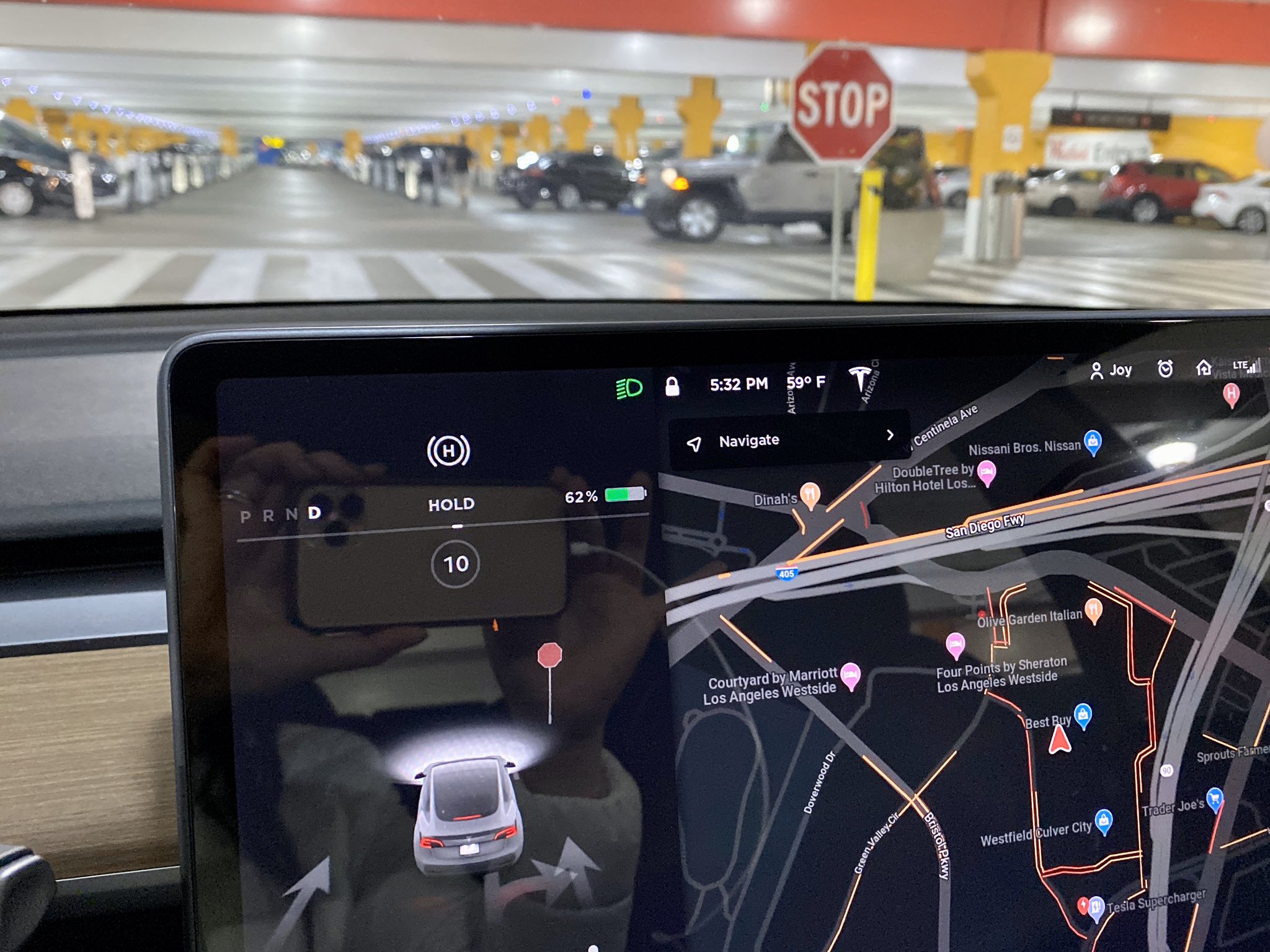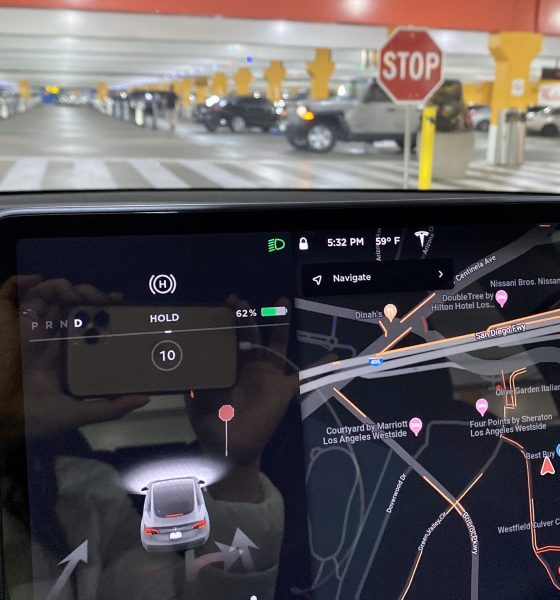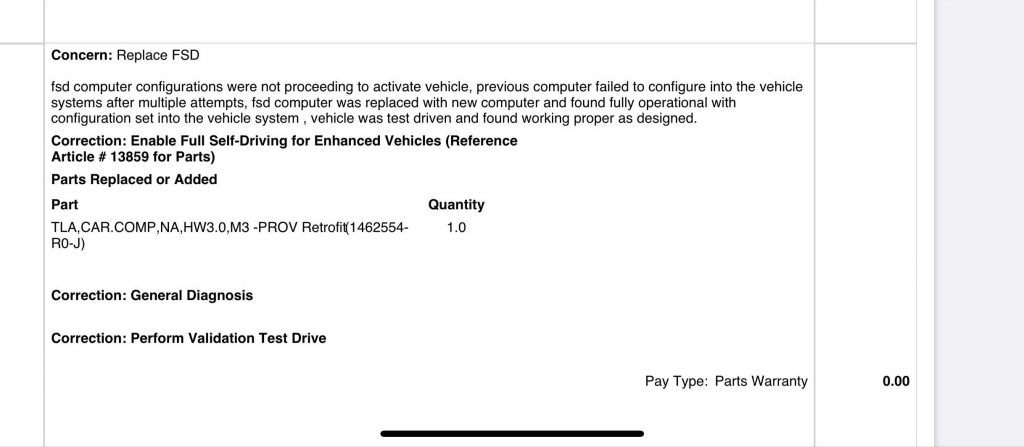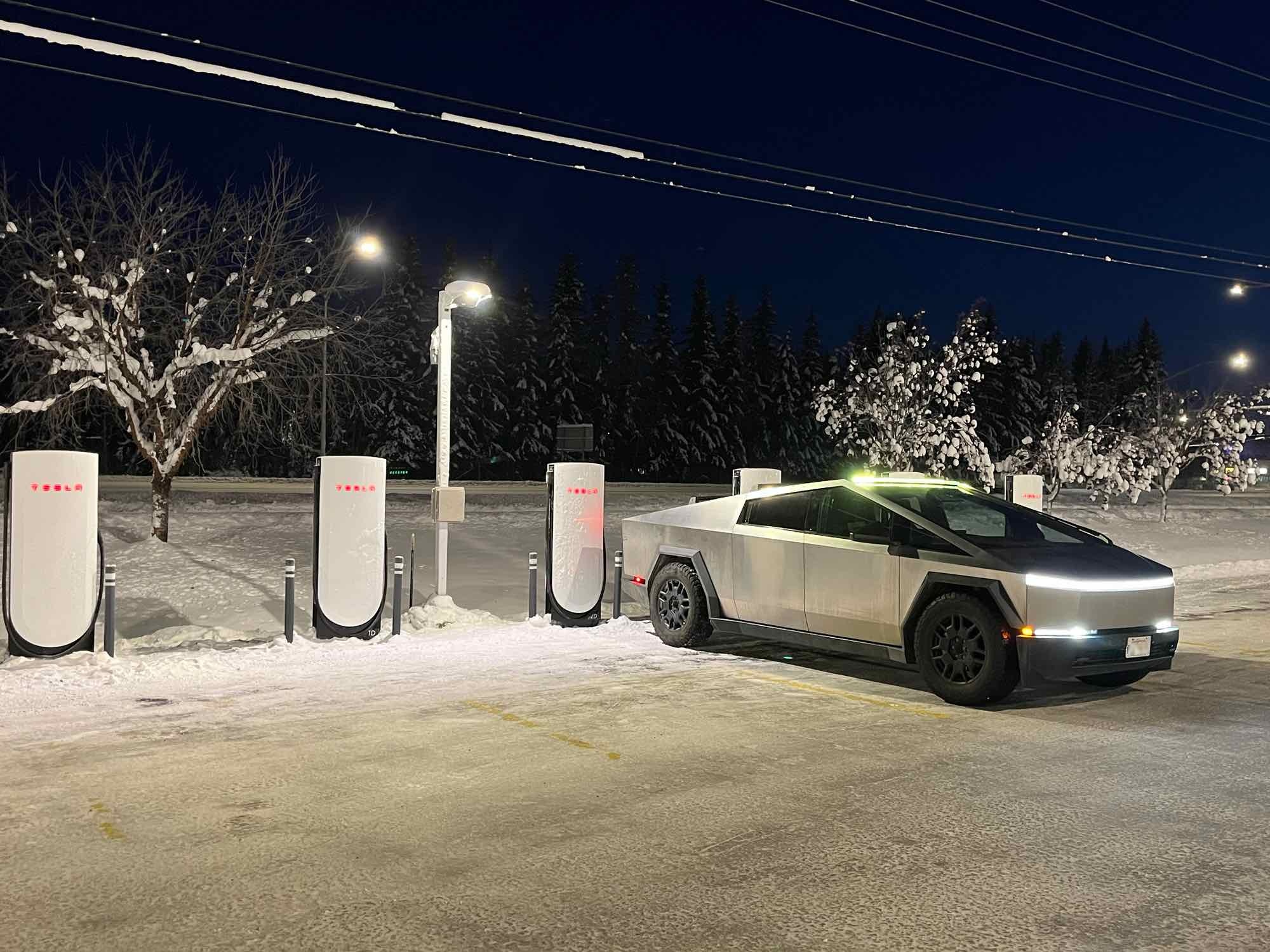

News
Tesla Model 3 gets Full Self-Driving HW3 upgrade: Full details with lessons learned
True to Elon Musk’s expectations on Twitter last month, it appears that Tesla is now looking to ramp Hardware 3 retrofits for owners who purchased the Full Self-Driving suite and whose cars are equipped with HW2 or HW2.5. A recent account involving a Tesla owner-enthusiast’s experience with her Model 3’s HW3 upgrade shows that there are still some areas in the retrofit process that can be improved.
Tesla Model 3 owner-enthusiast TeslaJoy was looking to do a video on the company’s recent voice command update when she noticed that the feature on her vehicle was not working properly. This prompted her to make an appointment with Tesla to get her car checked in and fixed. During the troubleshooting process, she inquired if a possible HW3 retrofit could be done to her vehicle as well. Fortunately, a HW3 unit was available for her Model 3, and so, a rather eventful upgrade process began.
Tesla Service Centers currently receive batches of HW3 units from the electric car maker, and each unit is assigned to a specific VIN. This is the reason why for now, at least, owners are not advised to call Tesla to schedule a HW3 retrofit. Fortunately for Joy, the Tesla Service Center opted to perform the HW3 upgrade at the same time as her appointment, since she would need to bring her Model 3 back for a retrofit anyway.

Since the retrofit was estimated to take around 5 hours, Tesla asked the Model 3 owner to leave her car for the day and claim it the next business day. That was December 31, which meant that the vehicle should be ready the day after New Year’s. As it would turn out, the Service Center would end up encountering difficulties installing the necessary firmware on Joy’s Model 3. This resulted in delays, which culminated in the vehicle’s HW3 retrofit being completed on January 5, 2020, over five days after the Model 3 owner turned in her car.
Hardware 3 retrofits are available for owners who have purchased Tesla’s Full Self-Driving suite, and whose cars are still equipped with the company’s HW2 and HW2.5 units. With Hardware 3 installed, owners will be able to utilize the full suite of FSD capabilities that the company is rolling out today. One of these is the FSD preview that Tesla rolled out for the holidays, as well as features like traffic cone recognition.
True to Elon Musk’s words on Twitter, the HW3 retrofit is free for owners who have purchased the company’s FSD suite. Joy, for her part, was able to get FSD last March at a discounted price of $2,000 on top of her Enhanced Autopilot. FSD currently costs $7,000 when it is included in a new vehicle’s order.
Based on Joy’s experience, it appears that owners should expect to wait some time for their vehicles are set to be retrofitted. In the Model 3 owner’s case, her car’s upgrade ended up taking days since the first HW3 kit that was installed did not function properly. This resulted in the vehicle essentially getting retrofitted twice, causing delays. Tesla did give Joy a $500 Uber voucher due to the absence of loaner vehicles, but the whole experience showed notable points for improvement nonetheless.
In a way, TeslaJoy‘s experience with her Model 3’s HW3 retrofit stands in stark contrast with the experiences of Model S owner Sofiaan Fraval, whose car was upgraded by a Service Center during a voluntary HEPA replacement. In Fraval’s case, his Model S was fully retrofitted within a matter of hours, and it was calibrated in pretty much the same day. A Tesla Model S owner who runs the Electric Dreams YouTube channel also received his vehicle’s HW3 retrofit without any issues, and it was performed by a mobile technician, not a Service Center.
In the Electric Dreams host’s case, the entire HW3 retrofit was conducted from the convenience of his home, with a mobile service tech coming over in the morning, taking an hour and a half for the installation to be completed, and an additional two hours for the necessary firmware to be loaded onto the vehicle. This is in line with Elon Musk’s previous statement on Twitter, where he stated that HW3 retrofits should be possible through Tesla’s mobile service fleet.
Overall, there seems to be a variance with regards to the experience of owners when getting their vehicles retrofitted with Tesla’s FSD computer. Some owners seem to be experiencing a seamless, painless process, while some, like Joy, end up having to test their patience. Hopefully, as Tesla ramps its HW3 retrofits this quarter, the company could work in optimizing its upgrade process, so there are more experiences like the Electric Dreams host’s, and less like TeslaJoy‘s.
Watch TeslaJoy‘s HW3 experience in the video below.

Cybertruck
Tesla updates Cybertruck owners about key Powershare feature

Tesla is updating Cybertruck owners on its timeline of a massive feature that has yet to ship: Powershare with Powerwall.
Powershare is a bidirectional charging feature exclusive to Cybertruck, which allows the vehicle’s battery to act as a portable power source for homes, appliances, tools, other EVs, and more. It was announced in late 2023 as part of Tesla’s push into vehicle-to-everything energy sharing, and acting as a giant portable charger is the main advantage, as it can provide backup power during outages.
Cybertruck’s Powershare system supports both vehicle-to-load (V2L) and vehicle-to-home (V2H), making it flexible and well-rounded for a variety of applications.
However, even though the feature was promised with Cybertruck, it has yet to be shipped to vehicles. Tesla communicated with owners through email recently regarding Powershare with Powerwall, which essentially has the pickup act as an extended battery.
Powerwall discharge would be prioritized before tapping into the truck’s larger pack.
However, Tesla is still working on getting the feature out to owners, an email said:
“We’re writing to let you know that the Powershare with Powerwall feature is still in development and is now scheduled for release in mid-2026.
This new release date gives us additional time to design and test this feature, ensuring its ability to communicate and optimize energy sharing between your vehicle and many configurations and generations of Powerwall. We are also using this time to develop additional Powershare features that will help us continue to accelerate the world’s transition to sustainable energy.”
Owners have expressed some real disappointment in Tesla’s continuous delays in releasing the feature, as it was expected to be released by late 2024, but now has been pushed back several times to mid-2026, according to the email.
Foundation Series Cybertruck buyers paid extra, expecting the feature to be rolled out with their vehicle upon pickup.
Cybertruck’s Lead Engineer, Wes Morrill, even commented on the holdup:
As a Cybertruck owner who also has Powerwall, I empathize with the disappointed comments.
To their credit, the team has delivered powershare functionality to Cybertruck customers who otherwise have no backup with development of the powershare gateway. As well as those with solar…
— Wes (@wmorrill3) December 12, 2025
He said that “it turned out to be much harder than anticipated to make powershare work seamlessly with existing Powerwalls through existing wall connectors. Two grid-forming devices need to negotiate who will form and who will follow, depending on the state of charge of each, and they need to do this without a network and through multiple generations of hardware, and test and validate this process through rigorous certifications to ensure grid safety.”
It’s nice to see the transparency, but it is justified for some Cybertruck owners to feel like they’ve been bait-and-switched.
News
Tesla’s northernmost Supercharger in North America opens

Tesla has opened its northernmost Supercharger in Fairbanks, Alaska, with eight V4 stalls located in one of the most frigid cities in the U.S.
Located just 196 miles from the Arctic Circle, Fairbanks’s average temperature for the week was around -12 degrees Fahrenheit. However, there are plenty of Tesla owners in Alaska who have been waiting for more charging options out in public.
There are only 36 total Supercharger stalls in Alaska, despite being the largest state in the U.S.
Eight Superchargers were added to Fairbanks, which will eventually be a 48-stall station. Tesla announced its activation today:
North America’s northernmost Supercharger Fairbanks, AK (8 stalls) opened to public. https://t.co/M4l04DZ6B5 pic.twitter.com/zyL6bDuA93
— Tesla Charging (@TeslaCharging) December 12, 2025
The base price per kWh is $0.43 at the Fairbanks Supercharger. Thanks to its V4 capabilities, it can charge at speeds up to 325 kW.
Despite being the northernmost Supercharger in North America, it is not even in the Top 5 northernmost Superchargers globally, because Alaska is south of Norway. The northernmost Supercharger is in Honningsvåg, Norway. All of the Top 5 are in the Scandanavian country.
Tesla’s Supercharger expansion in 2025 has been impressive, and although it experienced some early-quarter slowdowns due to V3-to-V4 hardware transitions, it has been the company’s strongest year for deployments.
🚨🚨 Tesla Supercharging had a HUGE year, and they deserve to be recognized.
🍔 Opened Tesla Diner, a drive-in movie theater with awesome, Chef-curated cuisine
🔌 Gave access to Superchargers to several EV makers, including Hyundai, Genesis, Mercedes-Benz, Kia, Lucid, Toyota,… pic.twitter.com/yYT2QEbqoW
— TESLARATI (@Teslarati) December 10, 2025
Through the three quarters of 2025, the company has added 7,753 stations and 73,817 stalls across the world, a 16 percent increase in stations and an 18 percent increase in stalls compared to last year.
Tesla is on track to add over 12,000 stalls for the full year, achieving an average of one new stall every hour, an impressive statistic.
Recently, the company wrapped up construction at its Supercharger Oasis in Lost Hills, California, a 168-stall Supercharger that Tesla Solar Panels completely power. It is the largest Supercharger in the world.
News
Tesla shocks with latest Robotaxi testing move
Why Tesla has chosen to use a couple of Model S units must have a reason; the company is calculated in its engineering and data collection efforts, so this is definitely more than “we just felt like giving our drivers a change of scenery.”

Tesla Model S vehicles were spotted performing validation testing with LiDAR rigs in California today, a pretty big switch-up compared to what we are used to seeing on the roads.
Tesla utilizes the Model Y crossover for its Robotaxi fleet. It is adequately sized, the most popular vehicle in its lineup, and is suitable for a wide variety of applications. It provides enough luxury for a single rider, but enough room for several passengers, if needed.
However, the testing has seemingly expanded to one of Tesla’s premium flagship offerings, as the Model S was spotted with the validation equipment that is seen entirely with Model Y vehicles. We have written several articles on Robotaxi testing mules being spotted across the United States, but this is a first:
🚨 Tesla is using Model S vehicles fitted with LiDAR rigs to validate FSD and Robotaxi, differing from the Model Ys that it uses typically
Those Model Y vehicles have been on the East Coast for some time. These Model S cars were spotted in California https://t.co/CN9Bw5Wma8 pic.twitter.com/UE55hx5mdd
— TESLARATI (@Teslarati) December 11, 2025
Why Tesla has chosen to use a couple of Model S units must have a reason; the company is calculated in its engineering and data collection efforts, so this is definitely more than “we just felt like giving our drivers a change of scenery.”
It seems to hint that Tesla could add a premium, more luxury offering to its Robotaxi platform eventually. Think about it: Uber has Uber Black, Lyft has Lyft Black. These vehicles and services are associated with a more premium cost as they combine luxury models with more catered transportation options.
Tesla could be testing the waters here, and it could be thinking of adding the Model S to its fleet of ride-hailing vehicles.
Reluctant to remove the Model S from its production plans completely despite its low volume contributions to the overall mission of transitioning the world to sustainable energy, the flagship sedan has always meant something. CEO Elon Musk referred to it, along with its sibling Model X, as continuing on production lines due to “sentimental reasons.”
However, its purpose might have been expanded to justify keeping it around, and why not? It is a cozy, premium offering, and it would be great for those who want a little more luxury and are willing to pay a few extra dollars.
Of course, none of this is even close to confirmed. However, it is reasonable to speculate that the Model S could be a potential addition to the Robotaxi fleet. It’s capable of all the same things the Model Y is, but with more luxuriousness, and it could be the perfect addition to the futuristic fleet.








